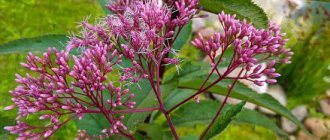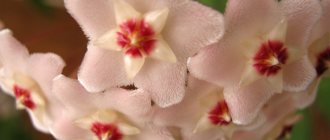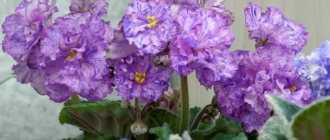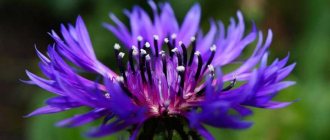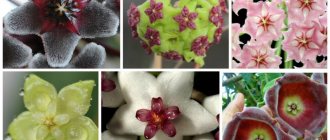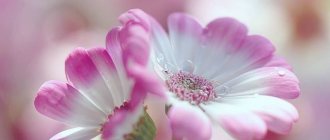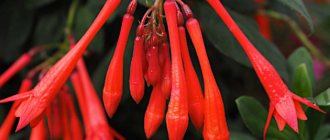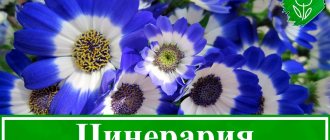Plants » Flowers
0
307
Article rating
Kira Stoletova
Hoya Pubicalix is considered one of the most striking representatives of tropical plants - it belongs to the Lastovneve family, native to Australia, India, and southeast Asia. The flower is successfully cultivated at home. Let's consider its characteristics, popular varieties, as well as the rules for caring for them.
Hoya publicix splash
Methods for propagating wax ivy
The easiest way to propagate home vines is by cuttings.
Under favorable conditions, they take root and grow without problems. Carefully cut a branch with a pair of leaves, and the cutting should have at least 2 nodes. Roots and leaves are formed in them. Next, place part of the plant in a dark vase and leave it in a warm, bright place. But do not forget to add fresh water, as moisture evaporates quickly. A strengthened young plant can be transplanted into a pot with a special substrate.
Propagation of wax ivy by cuttings gives excellent results.
But you should be aware that they should be short, since parts of the hoya that are too long are prone to drying out. It will be easier to root the vine if you maintain the room temperature at least 22 °C, and you also need to regularly spray the cuttings with water from a spray bottle.
Some gardeners are interested in how to propagate hoya with leaves
. The fact is that the petioles at the base of the leaf contain a certain number of roots. When placed in a nutrient substrate, this part of the plant takes root in the soil, but shoots are rarely sprouted. You can additionally stimulate the leaf by adding plant cell-based hormones to the water for irrigation.
You can also grow hoya from seeds at home. Fresh seed should be slightly dried and placed in a well-permeable substrate. For example, you can prepare a mixture of soil and sphagnum
It is important to know that grains should be sown quickly, otherwise they will lose their viability
As a rule, seeds germinate 1 week after placing them in a nutrient medium. Seedlings should never dry out, which is why they are regularly moistened with warm water. Young plants require a sufficient amount of light, so it is best to place the sprouts in a spacious container on the windowsill. 3 months after germination, the vines can be transplanted into separate pots. At this point, the hoyas have powerful roots and leaves.
Causes of common problems
Like most plant crops, wax ivy has characteristic changes in condition that indicate the presence of a problem. The most common such changes are:
- Falling leaves, lack of growth and the presence of a whitish coating on the stems most often indicate a spider mite.
- The absence of flowering indicates violations in the matter of care. First of all, lighting and temperature conditions.
- The appearance of spots on the leaf blades indicates sunburn, the use of cold water when watering, or excess fertilizer.
- Deformation of leaf plates and shoots indicates that the usual watering regime is insufficient.
- The presence of dark dots on young leaves is a characteristic phenomenon for Hoya.
- The edges of the leaf blades become brownish in color if there is an excess of nutrients or dry soil.
Flower growers recommend planting Hoya for people who do not have the time or experience in growing any kind of vegetation.
The requirements of “wax ivy” are insignificant and do not take much time, and the plant itself can green up a city apartment and give it some charm. CherryLink plugin not found
Purchase and adaptation
If you want to get a real plant with all the varietal characteristics, go shopping at a specialized store or flower nursery.
Hoya publicix photo
When choosing Hoya Pubicalix for your home, carefully examine its crown and soil.
Healthy seedlings have smooth stems, without cracks, growths, dryness or rot. The leaves are fresh, juicy, rich in color, without inclusions of unnatural color. The substrate is slightly moist, does not contain acidification and deposits on the surface.
The purchased plant is placed in a separate room for 3 weeks to give it time to adapt to the new conditions. During this period, you will be able to understand whether it is sick with something or not.
How to properly care for Hoya
Despite the unpretentiousness of wax ivy, the soil for this plant must be balanced and breathable. You can take ready-made soil for orchids or prepare a mixture yourself from the following components:
- leaf soil (2 kg);
- turf (1 kg);
- humus (800 g);
- river sand (500 g).
Any pot for the vine is suitable - both clay and plastic. The main thing is that there are drainage holes in it and moisture does not stagnate in the soil. For a small vine, a container with a volume of up to 1 liter is sufficient.
In the future, the plant should be transplanted into a wider pot as it grows.
The optimal temperature for wax ivy varies from 17 to 25 °C in warm months; in winter it can be reduced to 15 °C. Liana can be planted in a winter garden or greenhouse
, since it can withstand short-term drops in temperature without the risk of foliage falling.
The shoots of domestic vines often grow very long, so this is a mandatory procedure.
Choosing the shape of the bush allows you to get a lush and beautiful plant, the main thing is to have time to do this after the end of flowering. It is best to shape hoya using thin garden shears.
Wax ivy thrives in a humid environment, so the foliage should be periodically sprayed with warm water from a spray bottle. In spring and summer, hoya is watered abundantly as the soil dries, however, liquid stagnation in the soil should not be allowed
In addition, the contact of drops of water on flowers and buds contributes to the deterioration of their appearance, so the plant should be moistened carefully
Description of varieties
The evergreen vine, which is known as Hoya fleshy, or wax ivy, has a well-developed root system and a branched stem up to 10 m long, covered with hard, pointed leaves. Flowering, during which fragrant flowers of various colors bloom, collected in umbrella inflorescences, occurs in the summer.
Breeders have developed many varieties of Hoya carnosa, which differ in shape, color of leaf blades and flowers.
Among the most common and original representatives of the type species are:
- Variegata - form with pink flowers bordered by a white stripe;
- Exotica - a distinctive feature of the variety is the yellow color of the leaf blades, gradually acquiring a green tint towards the edges;
- Tricolor - a variety with leaf blades edged with a green border, which change the main color from red to yellow as they mature;
- “Crimson Queen” - the variety stands out for its rich pink flowers with a more delicate border around the edges.
Signs and superstitions
Hoya Bella's popularity as a houseplant has declined somewhat in recent years. It's all about the prejudices associated with plants. Some believe that liana-like plants, including hoya, are extremely undesirable in residential areas. They drain energy from homeowners, provoke scandals and quarrels, and also block cash flows. Some people even complain of poor health, loss of strength and performance if they spend a long time in the same room with Hoya Bella.
For your information! Proponents of Feng Shui theory believe that Hoya Bella is a very positive culture that protects its owner’s house from the evil eye, envy and enemies.
The choice of Hoya Bella variety depends on the decorative properties and purpose of growing the flower. Flower growers prefer fleshy hoya because it easily reproduces indoors and is less demanding in care. If you want to keep a beautiful flower in your house that will replace a bouquet, then beautiful hoya will serve as a good alternative for this purpose.
When and how does it bloom
Hoya flower - what the varieties Carnosa, Kerry, Bella, fleshy, multiflora look like
Hoya (Hoya) Pubicalix blooms for a short time, but surprises with the unusual shape and appearance of its buds. The inflorescences are spherical in shape, with up to 30 small buds on each of them. The most common flowers are pink, scarlet and grayish. The surface of the buds has small fibers that make the flower velvety to the touch.
Blooming Hoya Pubicalix Black Dragon
The flowers are shaped like a perfect five-pointed star. The lower row of petals is almost twice the size of the upper one.
Flowering period
On average, the Hoya Pubicalix species blooms from 1.5 to 2 weeks. Some varieties can bloom for a month, but this is rare in indoor conditions.
Hoya propagation
Propagation by seeds
Planting material must be well-ripened and dried. Seeds are prepared for planting in the year they are collected.
Plant the seeds in a loose earthen mixture consisting of sphagnum moss and a universal substrate.
Within a week, the seeds will germinate and shoots will appear on the surface of the earth. After this, it is necessary to water regularly to prevent the soil from drying out, and watering should be controlled so that the soil in the container does not turn into a swamp.
The bowl with seedlings should be in a bright place. As a preventive measure, the sprouts are treated with Bordeaux mixture or any other preparation containing copper. This will protect young plants from fungal infections.
When several pairs of leaves appear on the young shoots, they can be planted in separate flowerpots.
Note: this method is difficult for home conditions, since in indoor floriculture hoya practically does not produce seeds, and it is very difficult to find planting material in specialized stores.
Cutting method
This is the most common and easiest method to perform. Rooting of cuttings occurs quickly, resulting in a full-fledged, healthy plant.
You should choose cuttings of sufficient length, which have two nodes and several pairs of leaves.
Rooting is carried out in two ways:
- In water;
- In the substrate.
To root in water, you need to tightly wrap a container with water in foil, and make small holes on top for the cuttings. The lower leaves need to be cut off, leaving one pair of upper ones. The cut sites are treated with a growth stimulator. The bottom knot should be in the water. The temperature for root formation should not exceed +22 degrees, and high air humidity is also necessary. Such conditions will not allow the cuttings to dry out.
The container with cuttings must be covered with polyethylene, but the plants must be ventilated regularly. Within a few weeks, roots will appear and the plants can be planted in a separate container.
To root a cutting in a substrate, you must:
- Prepare soil that allows moisture to pass through well.
- Treat cuttings with a growth stimulator.
- Sterilize the soil mixture.
The cuttings are planted in the substrate so that the lower node is in the ground. Place polyethylene on the container and ventilate the seedlings. Plant growth will be noticeable after a few weeks.
Flower growers recommend soaking cuttings received by mail in water for several hours.
Hoyas - luxuriously flowering indoor vines
Hoyas are so popular that sometimes you can find them not in flower shops, but in gift shops. True, we are not talking about huge vines, but only about rooted leaves: green “hearts” that have taken root in a pot are an excellent gift for Valentine’s Day. But full-fledged hoyas have earned the status of one of the most “reliable” indoor vines. The plant received the “folk” nicknames “waxflower” and “wax ivy” for the seemingly waxy, unusually dense texture of the stars in the inflorescences and the special texture of the leaves.
Hoya is a genus of evergreen climbing, creeping or hanging shrubs and shrubs with long and thin shoots. The height of hoyas varies from 15 cm to 2 m. True, the tiny plants are the rooted leaves of Hoya Kerr, while all adult crops are much larger, although they are limited in height by the supports on which they grow.
Hoyas cannot be grown without supports, and choosing a specific shape and type of support allows you to modify the plant and its size as you please. Hoya leaves are dark, fleshy, but not too thick, leathery, always whole and located oppositely. And the shape and size of the leaves of individual hoi can be radically different.
Hoyas bloom from May to October. The flowers of this vine are unusually original, graceful, star-shaped, with an unusual double structure: inside the large five-pointed “star” there is a contrasting smaller star-crown. Both the shape of the stipules and their original waxy and sometimes almost furry texture made the plant stand out and become a legend. The stars of hoya flowers are collected in umbrella-shaped inflorescences, which most often droop and hang down like magical porcelain baskets.
Among the plants there are varieties with white, pink and cream colors, while almost always the star flowers are decorated with a dark or bright crown in the center. A distinctive feature of all khoyas is the ability to exude a surprisingly delicate aroma at night.
Hoya Kerrii. Zoran Jovanovic
Why does Crassula not produce buds and what to do about it?
The main reasons why Crassula does not bloom are improper maintenance conditions or flower disease.
- Crassula will not produce buds in bright sun; it prefers medium lighting and short daylight hours. The first thing you need to do to make it bloom is to place the pot on a north window, where there is little light.
- The soil in which the money tree grows should be slightly acidic. Fertilizers high in phosphorus can be used. You can grow Crassula in street soil, but in this case it will not have enough nutrients to bloom.
- The succulent does not require abundant and frequent watering; it is enough to do it once every 5-6 days. Excess moisture can cause dropsy on Crassula leaves - dotted light brown tubercles. And then the plant will have to be urgently transplanted into new soil.
- If Crassula is affected by pests, then you should not count on buds. Instead of wondering how to make it bloom, you need to carefully examine the stems and leaves. Spider mites and aphids cause leaves to dry out, scale insects announce their presence with brown oval tubercles on parts of the plant, and mealybugs with sticky white fluff. In these cases, Crassula is treated with a soap solution or special chemical compounds to kill pests. More information about pests and diseases of Crassula can be found here.
- Other common diseases of green friends can also prevent the flowering of the money tree: for example, fungi. It is necessary to treat the plant with fungicides, remove damaged parts, replace or disinfect the soil and pot.
Diseases and pests
Harmful insects and infections only attack weakened flowers that are not given proper care and attention. If they are identified in a timely manner, Hoya can be saved.
| Diseases and pests | Signs | Treatment | Prevention |
| Spider mites, scale insects, aphids, mealybugs | These are juice-sucking parasites that damage all organs - stems, buds, leaves. In places of parasitism, tissues die and become brown, yellow or black. The leaves wrinkle, dry out, fall off | At the beginning of infection, you can do without chemicals - cut out the diseased parts, treat with soap foam, infusion of garlic or tobacco. The advanced form is treated with insecticides - Karbofos, Actellik, Aktara or Fitoverm | Maintain the required level of humidity and temperature. Spray regularly, wash the leaves with soapy water once a month. Buy healthy flowers, cut out diseased parts in time |
| Root rot | Appears due to frequent waterlogging. First the root rots, then the stems turn black, become soft and watery | Such a flower is pulled out of the flowerpot and examined. If the roots are partially damaged, cut out all the rot and immerse it in a fungicide solution for an hour. Dry, transplant into a new pot with disinfected soil. A plant whose root system has completely rotted is disposed of, 2-3 cuttings are cut for propagation | Avoid overwatering, use warm water for irrigation |
Home care
Hoya is an easy plant to care for.
Landing
Plant in small pots with good drainage and a mandatory drainage hole. Since this is a liana, which is often grown indoors as an hanging plant, it is better to use a hanging pot.
Replanting after purchase
After purchase, the plant remains in the technological pot for some time, then it is transplanted into a flower pot, but it should not be much larger than the transport pot; hoya blooms more profusely in cramped containers.
Subsequently, they are replanted every 2-3 years in April. This plant cannot be replanted often, because even with the most careful replanting it begins to hurt.
Priming
The basis of the mixture for hoya is leaf soil, to which turf and humus are added in a ratio of 3:2:2, and mixed with a small amount of coarse sand. It is useful to add soil for orchids or sphagnum moss and crushed tree bark. The best commercial soil is suitable for palm trees.
Watering
In summer, the plant is watered abundantly, but only after the top layer of soil has dried.
If there is water in the pan, it must be drained, otherwise the roots will rot.
In winter, watering is significantly reduced. Hoya tolerates underwatering more easily than overwatering.
Air humidity
Since the plant comes from countries with a humid climate, it also requires high humidity at home.
Hoya should be sprayed regularly, but not on the buds and inflorescences.
Lighting
In its homeland, hoya grows in well-lit small forests, so at home it is placed on a southern windowsill, but it still needs to be shaded from direct rays. Lack of color affects flowering; hoya may drop buds or even fail to produce them at all.
Thermal mode
In summer, Hoya is quite happy with the room temperature typical for this time. In winter it is useful to reduce the temperature to 15 degrees.
Fertilizer
Hoya doesn't like too many nutrients. The vine is fed only during the flowering period, once every three weeks with mineral fertilizers and a couple of times during the period with organic fertilizers.
Reproduction
Most often, hoya is propagated by apical cuttings, which are cut 10-15 cm in length, and care must be taken that there are several buds on them. They are then rooted in wet peat mixed with sand. The higher the temperature, the faster rooting occurs. You can also apply pre-planting treatment with root.
Hoya propagates by air layering and leaves with an axillary bud, which are also planted in a peat soil mixture and placed in a warm place.
Trimming
Hoya does not tolerate pruning; it is better not to remove even old flower stalks, because flowers will appear on them again. Therefore, only damaged leaves are disposed of.
Briefly about the diseases characteristic of this flower
The risk zone is autumn, when the temperature drops sharply, light becomes insufficient, and air humidity rises.
You should not water the flower abundantly during this period, as rot or mold may appear. The substrate needs to be updated - the top moldy layer is removed, the pot is treated with a vinegar solution. If the lesions are severe, a transplant is required. It is necessary to reduce watering, add lighting with special lamps, and treat the substrate and leaves with fungicides.
But placing flowers near batteries is also not recommended . If the air gets too dry, the leaves will begin to turn yellow. The affected leaves are cut off, and the flower itself is fertilized with potassium mineral fertilizers. You can feed with simple potato broth.
The most common pest for Hoya Publicix is scale insects. It is collected by hand, the leaves are treated with soapy water. Alcohol treatment of leaves helps prevent scale insects.
Hoya Publicix - looks great in hanging flowerpots and compositions with various supports . In order for a flower to develop and bloom quickly and well, it requires a lot of effort and competent regular care.
Description and characteristics of the plant
The tropical liana Hoya Publicis (Hoya Publicyx) belongs to the evergreen flowers of the large Lastovnevy family. Natural varieties grow on the west coast of Australia, India, and southeast Asia. The plant was first discovered in early 1913 by researchers Ramos and Edano on the island of Luzon (Philippines). A few years later, the American botanist E. D. Merrill described the hoya in his famous four-volume work on Philippine flowers.
Hoya pubicalyx inflorescence
Note! On the Internet you can find an erroneous spelling of the flower - Hoya Publicis. Only one name appears in the botanical encyclopedia - Pubicalix
Hoya is characterized by curly thick climbing stems, reaching a diameter of 0.5 cm. The leaves are dense, leathery, variegated, 15 cm long and 4 cm wide. The color of the leaves depends on the plant variety and many external factors (lighting, watering, soil composition), but they are generally dark green with silvery-white spots of various shapes and sizes. Young leaves are most often purple or brown and acquire a typical color as they grow.
The inflorescences are umbellate, located along the entire length of the stem. They consist of 35-45 flowers, the shape and color of which can also vary depending on the type of plant. The color can be a combination of several shades from cream and pale pink to dark red.
For your information! The aroma of flowers is pleasant, sweetish, intensifying towards the end of the day.
What it looks like, what family it belongs to
Hoya Pubicalix belongs to the Kutrovaceae family - it is a perennial plant that grows in the form of a vine. The flower has long and dense oval-shaped leaves, which are painted bright green with small gray spots on the surface. The length of the plates can reach 15-20 cm, and the width is only 4-6 cm.
Pubicalix is highly decorative
Briefly about the history of appearance
Although Pubicalix is found in the wild on the coasts of Australia, the habit of growing it indoors came from Asian countries, especially India.
Homeland of the plant
The habitat of the shrub is tropical Australian and East Asian forests.
Home care
Brachychiton does not require special attention or maintenance. It is enough to follow certain rules of care.
Illumination
The plant loves bright light and tolerates direct rays of the sun well, but on the hottest summer days it is better to shade the flower pot. Eastern and western window sills are best suited for growing. On northern windows and in winter, brachychiton does not have enough lighting, so it is necessary to install illumination with phytolamps. They are placed at a distance of 50–60 cm from the pot, and the daylight hours are artificially extended to 8–10 hours.
Temperature
The optimal temperature in spring and summer is 23–27 degrees. With the onset of autumn, the temperature is gradually lowered, and in winter the plant is kept at a temperature of 12–16 degrees.
Brachychiton is also resistant to lower temperatures, and also grows well without a dormant period, but less actively.
In spring and summer, the tree is taken out to the loggia or garden. But they protect from precipitation.
Important. The room with the plant is ventilated year-round, as the plant loves fresh air.
How to water?
In spring and summer, brachychiton is watered abundantly, but only after the top layer of soil has dried.
With the beginning of autumn, the amount of water applied is reduced.
And with the onset of the dormant period, water rarely, while allowing the substrate to dry well.
At this time, the plant’s leaves fall abundantly; some gardeners try to prevent the process by watering the flower a lot.
This should not be done under any circumstances, as such actions can lead to rotting of the root system and the development of trunk porosity.
Plant fertilizer
From the beginning of spring until the end of summer, the flower is fed once every 3 weeks with special mineral fertilizers for cacti, which are diluted according to the instructions.
Attention. With the arrival of autumn and until the end of winter, fertilizing is stopped, as it can only cause harm.
Trimming
The trunk of the plant becomes very elongated during growth, which leads to a deterioration in its decorative properties and loss of compactness. Therefore, annual pruning is carried out in February - March. Young elongated shoots are removed. In this case, the process is carried out gradually so as not to harm the plant. First, one shoot is removed, and the next one is removed when the previous cut has healed.
Carry out the procedure very carefully, as the plant juice can cause skin irritation
Transfer
Brachychiton is replanted after the roots have completely entwined the earthen ball. Young specimens are replanted annually, adults – once every 3–4 years. The pot should be larger than the previous one by no more than 5 cm. The pot should be stable; ceramic and clay materials work well.
The substrate can be purchased at the store or prepared independently; for this, leaf soil, humus, sand and peat are mixed in the same ratio.
The process consists of several steps:
- A drainage layer and some soil are poured onto the bottom of the pot.
- The plant is carefully removed, the roots are lightly shaken and washed under warm water.
- Brachychiton is inspected, and if there are rotten roots, they are cut off.
- Afterwards, the tree is placed in the middle of the flowerpot and covered with earth.
Then water abundantly and apply the first fertilizing.
Reproduction
Brachychiton can be propagated at home, like other plants. There are two ways:
- Cuttings. During pruning, cut apical cuttings longer than 10 cm are treated with Kornevin. Then they are planted in a container with a peat-sand mixture. Cover with film or glass. Place in a warm place, periodically ventilate and moisten. Rooting occurs within a month. Afterwards the plant is transplanted to a permanent place.
- Seeds. This method is rarely used. Seeds are bought at a flower shop. Then they are soaked in phytohormone for a whole day. Then they are sown in a sand-peat mixture. Keep in a bright room at high temperature. When they reach 2–3 cm, they are picked into separate pots with a diameter of 9 cm.
Types of Hoya
The most common houseplants are Hoya Kerra and Fleshy.
Hoya Kerrii has shoots that can reach 2 meters in length.
But it is not the flexible creeping shoots of the steeplechase that attract attention, but the large leathery leaves in the shape of an inverted heart. The length and width of the leaves of this hoya reach 15 cm, and their color - rich, bright green - creates a feeling of freshness
The umbrella-shaped inflorescences are very elegant.
They contain numerous white flowers with a beautiful dark center and a base creamy color. The species grows slowly, remains stable in indoor culture and is well managed. In addition to the base plant, the variegata form with cream leaves is also very popular.
The more modest-sized fleshy hoya (Hoya carnosa) also deserves the attention of gardeners. This plant is originally called wax ivy. The shoots of the vine grow only up to 1 m, but it will outshine its fellows in the canopy culture. An elegant, if not graceful, plant needs a garter, flaunting fleshy, rather dark glossy leaves of a pointed shape, smaller than those of other species.
If you look closely, you can see small whitish and yellowish spots on the leaves of wax ivy. This hoya forms dense bushes and its leaves are evergreen. The inflorescences sit on short stalks, in small umbrellas. The individual flowers of wax ivy are very beautiful, star-shaped with a red crown in the center, giving the entire inflorescence a variegated appearance. In addition to the basic type, there is a more small-leaved Hoya of the compact form.
It is also worth paying attention to other types of hoya:
- The ampelous small-leaved beauty Hoya bella is a dwarf species that, although less common, is also very decorative. It is not so lush, but more densely leafy, with beautiful oval-shaped leaves up to 3 cm long with a pointed tip and numerous small drooping star-shaped flowers with a crimson center.
- Hoya imperialis (Hoya imperialis) is a climbing species with pubescent shoots, large oval leaves up to 20 cm long with an edge rounded at the base and pointed at the apex. The flowers are collected in hanging umbels, pink-red, with a pubescent crown, seeming like a shining vision.
- Hoya multiflora (Hoya multiflora) is a compact species with narrow, up to 14 cm leaves, unusually thin, prominent veins and yellow-white flowers, in which the outer star seems to be bent back. This hoya is famous for its lemon scent, flowers reminiscent of shooting stars, collected in inflorescences of up to 40 flowers each.
Hoyas are vines that are not that difficult to grow. But they require really careful care, constant monitoring and careful correction of conditions at the slightest sign of “dissatisfaction.” These beauties need sensitive, caring owners who can satisfy all their needs and provide the necessary care.
Hoya beautiful (Hoya bella). Peter GHoya majestic (Hoya imperialis). DougHoya multiflora (Hoya multiflora). Doug
Varieties
This species has several decorative varieties that differ in the color of their inflorescences and leaves.
Hoya publicix silver splash
Silver Pink
Botanical name: Hoya pubicalyx cv. Silver Pink. Synonyms: Silver Knight, Silver Prince, Pretty One.
The leaves are reddish or brown when young, and emerald when mature. The surface of the leaf plate contains asymmetrically located spots or streaks of a silvery tone. The flowers are bright red, 2 cm in diameter. From 20 to 25 small buds bloom in one inflorescence.
Silver Lee
Botanical name: Hoya pubicalyx Silver Lea. The variety is reminiscent of Pink Silver, but it has more rounded leaves and much less silvery specks on them.
Splash
Botanical name: Hoya pubicalyx splash. The hybrid was bred by Swedish breeders.
The base of the leaf blade is blunt, the tip is pointed, the color is greenish with silvery strokes. The flowers are bright crimson and contain a light crown, which gives them contrast.
Red Buttons
Botanical name: Hoya pubicalyx Red buttons.
A very beautiful hybrid flower with a specific aroma, was bred by American selection. The leaves are oval-shaped with a smooth and dense structure, pointed at the tips. The leaf blade is light green, covered with silvery streaks.
The flowers are bright red with gray hair. The crown is in the form of a five-pointed star of the same shade. The inflorescences are large - up to 10 cm, consisting of 20-25 flowers.
Black dragon
Botanical name: Hoya PublicyxBlack Dragon.
Hoya Publicix Red Button
An unusual variety with curly thin stems, dark green foliage covered with silver spots or stripes.
The inflorescences are dense, consisting of 20-25 small flowers. The marginal petals are dirty purple with dense hair. The crown is in the shape of a five-pointed star, bright pink.
Fresno beauty
Botanical name: Hoya pubicalyx cv. Fresno Beauty.
This is a plant with pink flowers, and the leaves are densely covered with silver or beige spots. Elongated leaf plate - size 10x4 cm.
Chimera
Full name - cv. Chimera (Royal Hawaiian Purple).
The inflorescences consist of numerous small buds with a diameter of 10 mm. From 20 to 40 flowers bloom in one umbrella.
Flowers in the shape of a five-pointed star with dark purple, almost black petals, densely covered with fibers. In the center there is a crown of the same shape as the buds, the color is bright pink.
Pink dragon
Full name: Hoya pubicalyx pink dragon.
A very beautiful variety with delicate pale pink flowers.
Bright Van
Botanical name: Hoya pubicalyx cv. Bright One
Its distinctive feature is a bluish-red corolla with a very bright pink crown.
How does it reproduce
Propagation of this exotic flower occurs according to all the usual rules for indoor plants and in traditional ways - by germination of seeds and cuttings.
Germination of seeds
Growing hoya from seeds at home is not practiced. This is due to the fact that Hoya Bella rarely produces pods when grown at home. If you still manage to collect the seeds, you can try to germinate them. To do this, they are well dried in the sun and sown in loose, light soil. The plant should germinate three weeks after planting the seeds. Once germinated, the shoots should not be disturbed until several true leaves appear. Only when the culture is well established can the sprouts be transplanted into separate containers.
Rooting cuttings
The plant is propagated mainly by cuttings. To do this, cut branches are dipped into water, where they quickly take root. Sometimes, when rooting cuttings, they are covered with film or glass, creating a greenhouse effect. With this method, they need to be ventilated often.
Hoya Bella cuttings
Leaf
Growing hoya from leaves is an extremely ineffective method. It is very rare that a new plant can be grown this way. The fact is that a leaf cut and placed in water quickly produces roots. However, when it is transplanted into the soil for further development, it seems to freeze in its development and does not release a shoot. This state of existence of the plant can continue for years.
For gardeners who still want to try a similar experiment of growing hoya, it is worth stocking up on a leaf of a plant that grew in natural conditions. After the roots have sprouted, plant the leaf in the soil and stimulate its further active growth and development with the help of hormonal drugs. Then there is a possibility that after some time the leaf will produce a separate shoot.
Watering and fertilizing when caring for hoya (with video)
An important aspect of caring for a home hoya flower is watering: moderate in summer, even less in winter. A feature of the culture is its ability to tolerate moisture deficiency well. In the warm season, you need to water the plant as the soil dries out, but it is still better not to let the earthen clod dry out. In order for the vine or bush to enjoy abundant flowering next season, a minimal amount of liquid will be required during winter dormancy. If the soil is waterlogged, the plant may begin to shed both leaves and shoots. Water for irrigation should be used that has settled and is soft.
The ready-made mixture “For flowering succulents” can be purchased at a flower shop, or you can make it yourself at home, taking into account the recommended ratio of components:
- 2% magnesium.
- 10% nitrogen.
- 11% phosphorus.
- 18% potassium.
The solution must be poured into the pot along the edge. During winter dormancy, the plant does not need to be fertilized. Also, fertilizing is not needed at all if the crop is transplanted annually into a new, not yet depleted substrate.
To learn how to organize proper care for your hoya, watch the video below:
Possible problems during cultivation
Problems with Hoya Pubicalyx often arise, especially in the autumn.
Pests
Scale insects, which multiply especially quickly in dry air, cause great harm to hoya. They eat fleshy leaves and lay their larvae on them, the plant withers, turns pale and dies.
Another pest is the mealybug, which leaves white mucus on the leaves. These whitish insects are noticeable on the foliage and are completely removed by washing the flower with a soapy solution.
Powdery mildew is caused by insect pests
Other problems
Due to stagnant moisture and lack of loosening of the soil, Hoya Pubicalix is prone to root rot and gray mold.
Too dry air causes the leaf blades to dry out, and yellowing or paleness may indicate a lack of certain mineral elements in the soil.
The most famous and decorative plant species are:
- Hoya Pubicalix Silver Pink - has variegated brown-scarlet foliage and lush pale pink inflorescences;
- Splash - a Swedish variety with umbrella inflorescences
Features of home care
Caring for Hoya is not difficult, the main thing is to create optimal climatic conditions.
Temperature
The flower does not tolerate heat well, so it is not recommended to increase the temperature above +25 degrees. During the rest period it is lowered to +18 degrees.
Lighting
The daylight hours should be long, but it is advisable to avoid bright lighting. It is best to place the pot not on the southern, but on the western and northern windows.
It is better to place the plant on western and northern windows
Watering
Tropical shrub requires abundant and frequent watering. In summer, hoya is watered every 2-3 days; during dry periods, the procedure is carried out daily. With the arrival of winter, 1 watering per week is enough.
Spraying
Spraying is a must; it can lower the temperature and moisten dry air.
Note! Spraying in the shower also helps clean the leaf blades of dirt and prevent pests.
Humidity
To keep the flower healthy and decorative, you need to maintain high humidity in the room - at least 80%.
Priming
Ready-made substrates for succulents and cacti work well. At home, the soil mixture is prepared from light turf soil, humus, crushed tree bark, perlite and charcoal. Before planting, the bottom of the pot must be covered with drainage material.
Feeding
It is most effective to use ready-made complex mineral fertilizers as fertilizers.
It is important that they have a lot of potassium, nitrogen and phosphorus. It is best to feed the plant in liquid form once a month.
Frequently asked questions about Hoya Publicalyx
Is Hoya Publicyx toxic?
Hoya Publicyx plants have a milk-like fluid inside them that is toxic in nature.
Consuming or coming in contact with the white sap can cause health issues or allergies. Therefore, it is better to keep the plant away from children or pets.
How to train hoya plants to grow along a path?
These vine plants can be trained to grow along any path; they can climb hanging planter, trees, or any wall in your home. These vines can grow up to 20 feet long with proper training.
Use bamboo or any other vertical support in the middle of the pot and tie the plant with it using twine or strings.
The best time to train the hoya plant is when it is young.
Why is my Hoya Publicyx plant not blooming?
The most common reason for no blooms in Hoya Publicyx is the light deficiency.
Always make sure the plant is receiving plenty of sunlight.
Sometimes changing the position or transplanting can also prevent the plant from blooming.
Moving the plant will disturb it and cause it to drop the buds before they open.
What is the best type of growing soil for Hoya Publicyx?
The best soil for Hoya Publicyx Splash Plants is a well-balanced mixture of peat moss, perlite, and vermiculite that dries between watering but does not compact quickly.
You can add a slow-release granular fertilizer to help the plant in the transplanting transition.
How can I remove hard water spots from hoya Publicyx leaves?
You can use 1 teaspoon of white or red vinegar with a pint of warm water to remove water spots from the leaves.
Dip a small piece of cloth in the solution and rub the leaves gently in a circular motion.
Rinse with clean water and dry the leaves using another cloth.
Care
Watering
Moisturize regularly, but moderately, because Hoya does not tolerate frequent overflows. In spring and summer, the frequency is once a week, in the cold season - every 14 days.
Hoya publishedlis splash
After moistening, the soil is loosened to prevent the formation of a crust on its surface.
Fertilizers
Regular nutrition helps to quickly grow green mass, roots and increases immunity against diseases. They use ready-made complex mineral fertilizers for growing cacti and succulents. Feed during the growth and flowering period once every two weeks. After fertilizing, water thoroughly.
Trimming
Does not need shaping, because it does not tolerate this procedure well and may die. Only dubious branches and stems that have turned yellow, dried out or rotted are cut out.
After flowering ends, cut off the dried inflorescences. The flower arrows are left untouched; next year new buds will form on them.
Transfer
The purchased flower is replanted three weeks after quarantine. Take a pot made of plastic or ceramic, 2-3 cm in diameter larger than the previous one and always with holes in the bottom. Expanded clay is placed on the bottom, then nutrient soil. The plant is watered, removed from the old container, and transferred to a new pot.
Young flowers need to be replanted every other year, adults once every five years.
It is also necessary to replant a hoya whose roots have rotted. They are pulled out, washed from the substrate, rotten parts are cut out, dried, and treated with a fungicide. Plant in a new pot with sterile soil.
general information
Hoya is a genus of tropical evergreen plants of the Lastovniaceae family, named after the English gardener Thomas Hoy, who worked in the greenhouses of the noble Duke of Northumberland.
Plants of this genus differ in appearance, origin and color of flowers, but they all have certain similar features. Thus, all hoyas are characterized by fairly rapid growth, endowed with green, pointed, oval-shaped leaves and lignified shoots with aerial roots.
Their flowers are fragrant, bisexual, collected in umbrella-shaped inflorescences located on stem branches.

